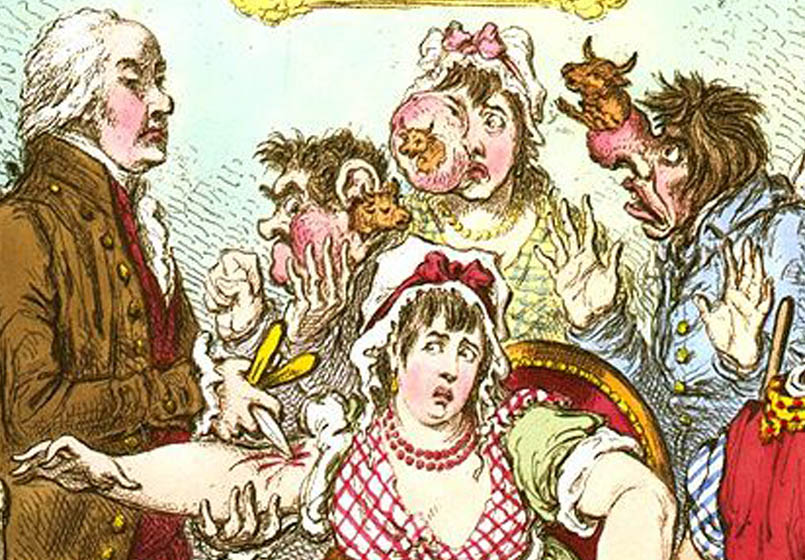It should have been a terrifying warning. Edward Jenner, teenage apprentice to a country surgeon in a sleepy English market town, told a local milkmaid there was a smallpox outbreak in the area.

It was the 1770s, and smallpox was a hideous disease that killed many and blinded and disfigured many more.
But the milkmaid wasn’t concerned: “I cannot take that disease, for I have had cow-pox.”
Coxpox was a cattle disease dairy workers often contracted but without serious harmful effects.
Jenner was intrigued. Years later, in 1796, he started deliberately injecting people with cowpox to prevent their contracting the far more harmful smallpox. (The word ‘vaccination’ comes from the Latin word for a cow.)
His technique was primitive by modern standards, and carried a risk of blood poisoning and other infections. But it worked, more often than not.
But many people objected to the idea of being injected with cells from an oozing sore on a sick animal.
The most basic concern: Would absorbing a living part of an animal make you part-animal?
Jamaica-based doctor Benjamin Moseley saw it as a serious danger.
“Can any person say what may be the consequences of introducing a bestial humour into the human frame, after a long lapse of years?” he wrote in 1800.
“Who knows, also, that the human character may undergo strange mutations from quadruped sympathy?…
“Owing to vaccination the British ladies might wander in the fields to receive the embraces of the bull.”
“Who knows but from vaccination a brutal fever will arise, and hence some modern Pasiphae may rival the fables of old?”
(In Greek mythology, Pasiphae, an immortal daughter of the sun, mated with a bull and gave birth to a monstrous hybrid bull-human creature, a minotaur.)
Moseley’s theories met with ruthless derision at the time – a cartoon shows a young woman, having become a modern Pasiphae after her smallpox vaccination, presenting her baby, a hybrid cow-human creature complete with horns, to her horrified mother.
But Moseley claimed to have observed the “bestial transformation” in his own patients: “Sarah Burley, whose face was distorted, and began to resemble that of an ox; and Edward Gee, who was covered with sores, and afterward with patches of cow’s hair.”
“William Ince … was vaccinated, when four months old. Soon after the cow-pox he broke out in sores and eruptions, nearly all over him.”
“When the sores dried up there appeared, on his back and loins, patches of hair, not resembling his own, for that was of a light colour; but brown, and of the same length and quality as that of a cow.”
Ferdinand Smith Stuart, a follower of Moseley, published his own pamphlet describing a more alarming case:
“ … a child at Peckham, who, after being inoculated with the cow-pox, had its former natural disposition absolutely changed to the brutal; so that it ran upon all fours like a beast, bellowing like a cow, and butting with its head like a bull!”
The cartoonist James Gillray lampooned vaccine opponents, showing a group of freshly vaccinated people overcome with alarm as cattle emerge from their orfices while a doctor looks on with glacial indifference:
An anonymous poem mocked Mosely in 1808, describing a parent watching his vaccinated children turning into cattle:
There, nibbling at thistles, stand Jem, Joe and Mary;
On their foreheads, oh horrible! crumpled horns bud:
Here Tom with a tail, and poor William all hairy,
Reclin’d in a corner, are chewing the cud!
The writer derisively captures the tendency to blame any human misfortune on vaccination:
Should a mason or carpenter fall from a scaffold,
And maim, bruise or fracture, poor fellow! his frame,
Or a horse throw his rider, – what – shall I be baffled,
In fixing on vile vaccination the blame?
And, in response to Moseley’s claim that cowpox would cause bestiality:
Beware vaccination! Which, if we connive at,
Will fill the whole world with incontinence full;
Produce matroniz’d nymphs, ere they fifteen arrive at,
And in every young stripling a rampant mad bull.
For the virus of beasts will engender their vices,
An axiom, my friends, ‘tis in vain to dispute,
Since a kind-hearted cobbler, you see, in a trice is
By vile vaccination transform’d to a brute.
Others, such as doctor John Birch, bemoaned losing the useful eugenics a disease that targets the poor could provide.
“Birch believed that vaccination was unnatural and damaging, because if it did work (which he doubted) it could undermine the valuable role that smallpox played in killing off the children of the lowest classes, as ‘a merciful provision on the part of Providence to lessen the burden of a poor man’s family,’” British medical historian Gareth Williams wrote.
“There have been anti-vaccination sentiments since there have been vaccines,” University of Toronto epidemiologist David Fisman said in an interview.
“When smallpox surfaced in Montreal in the late 19th century, a lot of parish priests in lower Montreal were anti-vaccine – they thought it was a conspiracy by the Westmount WASPs to make Catholics infertile.”
Toronto, both before and after the First World War, was bitterly divided over smallpox vaccination.
During a 1906 smallpox outbreak, Toronto’s school board voted down a resolution calling for all students to be immunized.
One trustee demanded that the “arbitrary pollution of children’s bodies in Toronto with animal matter be abandoned,” the Star reported.
Another called for vaccines to be abolished altogether.
A Star editorial at the time argued doctors should put more effort into making the case for vaccination against a “vigorous and persistent campaign against vaccination in Toronto.”
But by 1919, when another epidemic infected 2,800 Torontonians with smallpox, most embraced the vaccine.
As in the 18th century, smallpox vaccination had its problems, historian Katherine Arnup explains. The lymph used in the vaccination itself could be contaminated, sometimes with streptococcal bacteria, or be inactive, while the ivory points used to break the skin weren’t always cleaned between patients.
But pushback continued.
The vaccine “has been made from the grease taken from the heels of horses, from swine-pox, and even from corpses,” Henry Becker, described by the Star as “a prominent homeopathic physician,” told sympathetic city councillors in 1919.
(Charles Hastings, the city’s medical officer of health, left the meeting in disgust, saying he “hadn’t time to listen to that talk,” the Star reported)
The city’s vaccination efforts could be heavy-handed: Angry parents complained that their children had been vaccinated at school despite proof in writing (and scarring) that they had been vaccinated before.
Hundreds of people attended noisy anti-vaccination rallies. In a bizarre episode, one in November, 1919 conflicted with a war bond fundraising rally at City Hall – now Old City Hall – and was drowned out by the sound of bagpipes and the rumble of French tanks left over from the First World War.
“Are you going to let four or five men in authority shoot the dope into your innocent boys and girls?” First World War veteran George Conover asked the crowd, to roars of “No!”
But public health officials had the last word. Five years later a new vaccine against diphtheria – the leading killer of Canadian children – was introduced in Ontario on a large scale. The vaccinations saved dozens of lives a year in Hamilton alone.












Comments